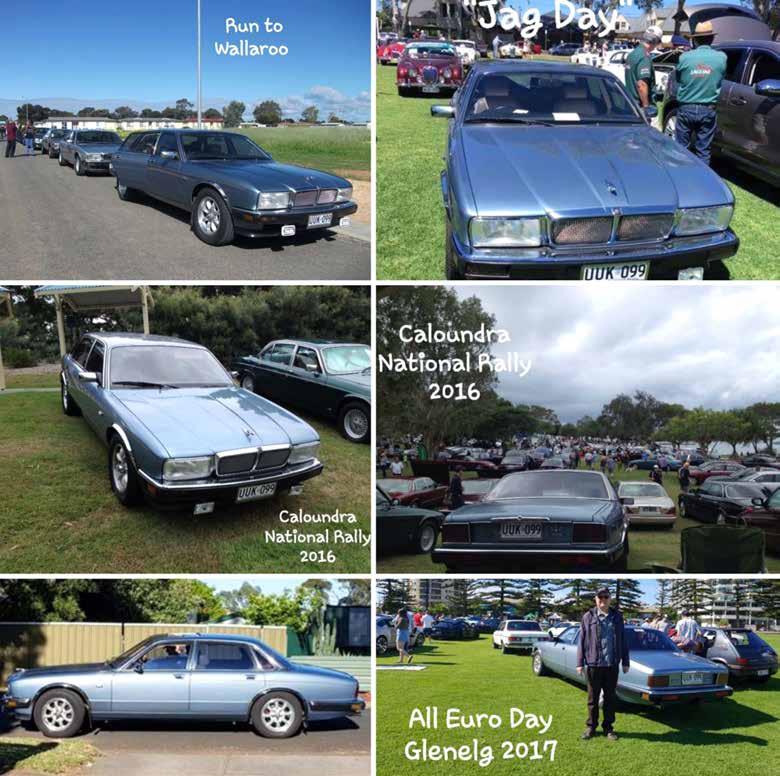
4 minute read
Members XJ40 Story - James Mann
I joined the JDCSA in 2004 at that time I had a 1973 Jaguar XJ6 Series 1. I kept this car for a few years on Historic registration, the main reason for joining the club. I went on a few trips in this car including a club run to Mount Gambier back in 2011 which was a great Weekend. I got the XJ40 in 2012 and love it although I have had a few issues like having to re-solder the dash cluster which is a known problem with these early XJ40’s. In 2016 we took it to Queensland for the National rally and covered 5000km’s in 10 days, it needed a bit of preparation before the trip including a new radiator, brake rotors and ball joints and a water pump, but made it OK other than having to replace a blown power steering hose in Dubbo. Recently it has had reconditioned Brake Calipers, a genuine Jaguar reconditioned water pump (beware aftermarket parts) a second-hand thermostat housing as it cracked, and a new thermostat. Also, second hand rear suspension struts. Work to do is to fix the electric Arial and take out the CD player and put in an original radio, who listens to CD’s these days anyway! Apparently, there is a way to solder an iPhone jack in to the original radio so I may do that. Looking forward to some runs this year hopefully be a better year for all of us.
James Mann


JAGUAR has launched a “C-Type” Continuation model.
In 2021, 70 years since its launch onto the world’s racetracks, JLR will restart production on a strictly limited run of the ultimate 1953 disc-brake specification. Since 2014 Jaguar has been in the business of reviving its classic cars, and the latest example from the company has just been announced this week: a limited-edition, hand-built version of the C-type race car, honouring the model’s 70th anniversary. Specifically, the new C-type will be modelled after the version of the car that won the 24 Hours of Le Mans in 1953, driven by Tony Rolt and Duncan Hamilton, and equipped with disc brakes. That’s an important clarification, as the company notes, because the production C-types built back during the original run in the 1950s were solely equipped with drum brakes. Each car will also include the race car’s more powerful 220 hp 3.4-liter inline-six engine. Not just for the showroom, these new hand-built C-types will allow owners to get behind the wheel for Jaguar Classic Challenge racing, track and closed-road use. Jaguar began the Continuation endeavour by resuscitating the Lightweight E-type, a car model widely regarded as one of the most elegant ever to hit the tarmac. Then they brought back the XKSS, the D-type and finally the C-type, which built up its racing legacy from the Mille Miglia to the Targa Florio. All have been offered in limited numbers, sometimes as low as six, and often they’re all spoken for by the time Jaguar publicly announces the project. But this time, there are still some build slots available if you have US $1.3 million (according to per Bloomberg). .

Jaguar isn’t content with honouring the past, so it’s continuing it with its famous C-Type
Ecurie Ecosse to Build Continuation C-Type’s
Historic British racing marque Ecurie Ecosse will produce seven continuation models of its 1950s Jaguar C-Type racing car. Between 1951 and 1955, the Scottish race team used seven C-Types to pick up 59 podium places. Now Ecurie Ecosse will honour this success with the creation of a modern sibling car for each original racer. The continuation models are to be near-identical to the 1950s cars. Handbuilt in Coventry like the originals, the new C-Types will retain a thin-gauge aluminium body echoing the 1950s Malcolm Sayers design. Maintaining the historic detail, the new models will also ape the originals’ steel spaceframe chassis, although these are to be widened and made stiffer. Finishing the look, the continuation cars are to be painted in Ecurie Ecosse’s iconic blue and white racing livery, including hand-airbrushed Ecurie Ecosse shields. The C-Types are to be powered by an uprated version of the Jaguar’s original straight-six XK engine increased to 4.2-litre capacity and fuel injection. Power is to be transmitted via a five-speed manual transmission that, although not strictly historically accurate, is claimed to maximise the C-Type’s power and speed. Further enhancing performance, the suspension and disc brakes will also be tweaked. With these changes, the cars should manage a top speed of 250km/h. The first C-Type continuation is complete but the firm has yet to reveal prices. . .


